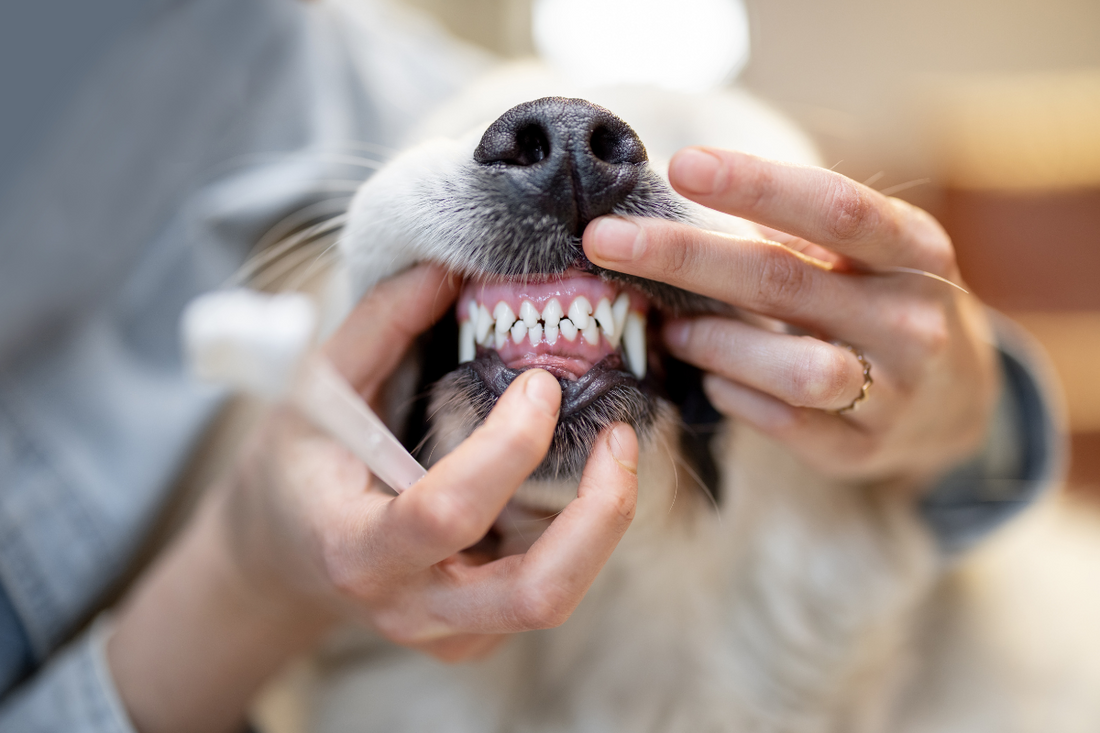Help My Dog’s Tooth Is Loose! Here's What To Do...

Like us, your dog’s tooth can get loose too! But why? Let’s talk about it.
Losing primary teeth is typical for puppies, but in adult dogs, a loose tooth may indicate an injury or dental disease. Dental disease develops over time, providing an opportunity to prevent tooth loss through proper dental hygiene.
Preventative care is the best approach to avoid dental issues. However, if you notice a loose tooth in your dog, it's crucial to seek advice from your veterinarian. This ensures your dog gets prompt and appropriate care. Your vet can also provide tips for enhancing your dog's dental health.
💡 FUN FACT: Puppies have 28 primary teeth, and adult dogs end up with 42 adult teeth.
Why Do Dogs Lose Their Teeth?

According to Vet doctors, adult dogs primarily lose their teeth for two reasons. The first is due to injury from biting into hard objects like sticks, rocks, or even furniture. The second, more prevalent cause is dental disease.
Despite having less sugar in their diets compared to humans, dogs are still susceptible to developing dental tartar and decay because as tartar builds up and hardens on the teeth, it creates an ideal setting for bacteria to thrive. This bacterial growth can lead to inflamed gums and root decay, eventually causing the teeth to become loose.
Identifying a Loose Tooth in Your Dog
All dogs, regardless of size, have the same number of teeth. However, some smaller dogs often have more crowded mouths, particularly breeds with shorter snouts like Pugs, Pekingese, and Bulldogs. This crowding can make it harder to spot a loose tooth.

Like people, dogs can also accidentally bite down incorrectly and break a tooth. It's easier to spot a broken tooth if it leaves a stub or sharp edge. But if the break is near the gum line, it's harder to see.
To spot a loose or wiggly tooth in your dog, watch for these signs:
- Tilting their head to one side while eating
- Chewing only on one side of the mouth
- Hesitation to play games like tug-of-war
- Avoiding picking up toys with their mouth
- Preferring soft, canned, or home-cooked meals over dry kibble
- Eating dry food only when it's softened
You dog does not know that they are experiencing dental problems, and they usually think that discomfort is normal. So as a dog parent, you must address their dental issues early on.
How to Prevent Tooth Loss in Dogs?

Like us humans, preventing dental disease in dogs also begins with regular brushing. And if you start brushing your dog's teeth since they were a puppy it can slow down the development of dental issues or tooth decay.
Training your dog to enjoy tooth brushing requires patience. Here are some simplified steps to help make brushing your dog's teeth a positive routine:
- Gently touch the outside of your dog’s mouth and reward them with a treat for cooperation.
- Lift the dog's upper lip to expose the teeth and gums, touch gently, and do the same with the lower teeth and gums. Reward with a treat and praise.
- Use a dog-specific toothbrush that fits on your finger. Start by gently touching your dog’s teeth with the brush, without toothpaste, to get them used to the feel.
- Introduce a small dab of dog toothpaste on your finger and let your dog taste it.
- Begin brushing the upper teeth gently, lifting the lip as needed, and rewarding your dog afterward.
- Gradually move the brush to the sides and back areas of the mouth on the top and repeat with praise.
- Follow the same steps for the bottom teeth.
💡 Bonus Tip: Keep brushing sessions short, about 30 to 60 seconds, alternating sides from day to day.
Make sure your dog is comfortable and happy during sessions. If your dog growls or tries to bite, stop right away. Safety first—don’t do anything that could hurt your dog.
Be careful with toys and chews too. Tennis balls can damage your dog’s teeth because they are rough. Hard chews like bones or antlers can also break teeth. Choose safer toys instead.
Do Dogs Really Need Professional Dental Cleanings?

Regular home toothbrushing is important, but professional cleanings are still necessary for your dog's dental health. Professional cleanings require general anesthesia to allow for thorough work and X-rays, which check under the gumline. Consistent brushing at home can lessen tartar buildup, reducing the frequency of professional visits and making them safer and more cost-effective.
If there is a slight discoloration near the gumline is normal due to tartar. A tooth's discoloration to gray or blue could indicate underlying issues. Catching signs of discomfort early can prevent serious problems.
Disclaimer: Joyride Harness is not affiliated with medical professionals. Consult your veterinarian with any medical concerns.
This is just a sampling of informational roundups we offer at Joyride Harness. You can find more tips and tricks and how-to’s for caring for your dog on our blog at this section. Feel free to leave a comment with things you’re looking for!





















